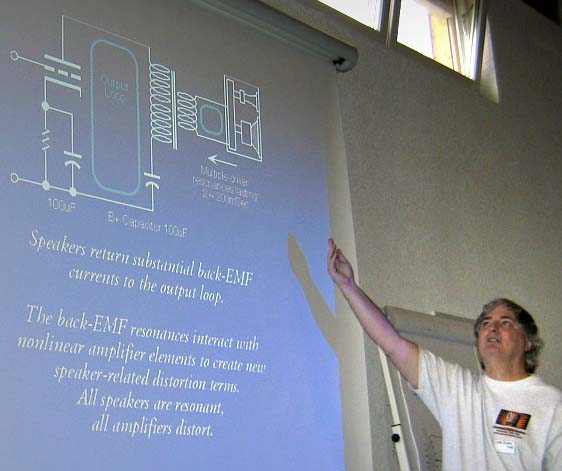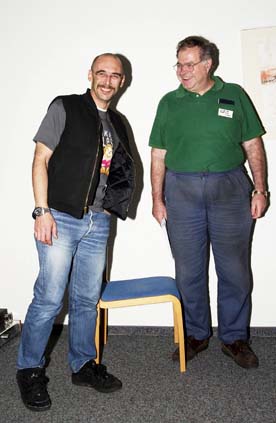Part 3

(Photo credit by Johannes LeBong)
Even though I made up most of the talk as I went along (using PowerPoint as a memory aid), and recruited John Atwood for 15 minutes of it, it seemed to be well received, and there were lots of questions at the end. Unlike the similar presentation I gave at the Bay Area Tube Fest, the concepts this time had actually been tried out in the Karna amplifier, and expanded by other researchers, most importantly Mark Kelly in Australia and John Atwood in the USA.
You can find a brief summary of the presentation here. It was a mostly theoretical presentation that urged people to let go of thinking about "signal path" in the usual sense, and think instead about the current loops within an amplifier, and the sources of distortion within that loop. This leads to the realization that power-supply filter and cathode-bypass caps are indeed in the "signal path", and failing to account for currents on the ground-side of a circuit can lead to ignoring sources of noise and distortion.
The picture shows the third part of the presentation, where I urge the audience to consider the interaction between the many resonances of the loudspeaker and the sources of distortion within the amplifier - which create in turn new artifacts that are not present in either the amplifier or the speaker by itself. At most shows, most of the audience has either designed speakers or amplifiers, but very few have designed both. The ETF was an exception - maybe the first show I've been to where more than five members of the audience have designed both, so they understood the point I was making here.
This was also the first show where I was pretty sure most of the presentation didn't go over their heads - the questions for John Atwood and myself were sharp and on-point. From the audience reaction and the questions asked you could tell the ETF was a show for designers, instead of marketers, retailers, or consumers. Once again, thank you, Christian Rintelen, for organizing a show at this level.

(Photo credit by Jim de Kort)
Steve Bench's (Christian is on the left, Steve on the right) inductor/resistor-equalized phono preamp sounded magnificent at Christian Rintelen's place before the show started, and wowed the show-goers at the ETF.04. The live demo on the big system made the point of removing capacitor coloration better than I could have - the sound had a freshness and directness noticed by everyone present, and was clearly different - and better - than the usual RC equalization that we've heard with every other preamp.
The clarity and sense of ease in the high frequencies was the biggest difference from conventional preamps - with an easy-to-drive inductor-based RIAA network, the tubes had a much easier job above at high frequencies, and sounded it. The subtle masking of low-level detail and slight metallic edge of caps in the RIAA was also noticeably absent - the sound was much closer to the directness of a first-generation mastertape than usual for a phonograph record. A lot of the "record-sound" coloration we've been attributing to the cartridge/arm combination turns out to be a type of preamp coloration instead.

Jean Hiraga, long-time editor of "Revue du Son", gave a truly inspiring talk and musical presentation - a highlight not just of this show, but any show. Why?
Jean Hiraga, son of a Japanese father and a French mother, was in a unique position to bridge the European and Japanese world of audio, speaking both languages fluently, and with a deeply felt attachment to the art and craft of high-fidelity sound. He was exposed to Japanese triode culture in the mid-Sixties - twenty-five years before the American triode revival in the early Nineties - and brought it back to Europe.
He wrote some of the first articles analyzing the desirable harmonic characteristics of direct-heated triodes, and is directly responsible introducing the sound of DHTs to France, Italy, in time, the rest of Europe, and finally, to the English-speaking audio world. Without Mr. Hiraga, there would have been no Sound Practices magazine, no VSAC, and no ETF - the English-speaking audio world would be nothing but high-watt mainstream and home-theater equipment. Fortunately for music lovers everywhere, events took a different path.

Jean described the origins of high fidelity and stereophonic sound from a uniquely European and Japanese perspective different than the usual Anglocentric accounts, making the point with extraordinary recordings none of us had known existed, much less actually heard for ourselves.
The most powerful of these was the very first stereophonic high-fidelity recording ever made - the Berlin Philharmonic playing a Bruckner symphony, recorded in 1944 at the height of the Second World War. Despite the appalling conditions, perhaps because of them, it was an extraordinarily powerful performance and a stunningly good recording.
On the technical side, it was surprising to think that less than a year after the AC bias technique was discovered by accident at AEG Telefunken, they would be making not just startlingly good high fidelity recordings, but experimental stereophonic recordings as well. Despite the extraordinary difficulties of working in a nation at war, the technicians were able to find the equipment to make these recordings, which sounded anything but primitive - in fact, the sound was comparable to a RCA Living Stereo mastertape, in some ways as good as anything made now in terms of presence and realism.
It was the sheer realism that made it more than a little unnerving, since you could so easily hear the emotional intensity of the musicians, living under Nazi German sponsorship and oppression, combined with Allied bombing campaigns that are actually audible on some recordings (although not this one).
As I listened, I was moved to tears - realizing what 1944 must have been like - one of the darkest times in all of human history, the SS death camps running full speed, the Russians overrunning the Germans on all fronts, the crazed Nazi fever dream as it neared its final end, the V-2 rocket screaming on its way to London and many years later, to the moon - and this, perhaps the strangest artifact of all, a beautiful piece of music beautifully recorded, a lotus flower growing out of the muck and mire and destruction of total global war, a few meters of piece of paper tape rescued from Russian archives, and brought back to life sixty years later.
As the Brucker movement came to an end (only one movement was recorded in stereo), I felt calm - not just the music, but reflecting on our own time. We have challenges, to be sure, but surely nothing like the world of 1944. If life and beauty can arise from that time, it can arise in ours, even if we are not aware of it now.
Thank you, Mr. Hiraga. You gave us all a gift none of us expected - we expected history, you showed us life and beauty, and reminded us why we do audio in the first place. Thank you.

A small part of Thomas Mayer's electronics which powered the big system during J. Hiraga's demonstration.
Just think: German music and technology, stolen and archived by Russians, retrieved by a man of French and Japanese ancestry, played on equipment built by Germans, using German, Dutch, and American tubes and Japanese/American loudspeakers. That alone speaks to the international character of art, science, music, and passion, an unspoken but very real part of the European Triode Festival.

Another close-up, this time showing Josef Aigner's CD output stage, but built with T. Mayer's impossible-to-describe tinkertoy construction technique. Thomas has obviously started a trend in Germany - everything out in the open, and as far from EU safety regulations as imaginable. (Look but don't touch, honey!)
More than one conference-goer told me stories of their experience of visiting T. Mayer's apartment, where he has his "full-sized" system, and the experience of being confronted with the radiant heat coming off a 6-foot high rack (built with the same techniques) that houses a gigantic array of damper diodes, the whole thing fed with three-phase 440VAC German industrial power ... and that's just the main power supply! Apparently Thomas does not need to heat his apartment at all during the winter - well, as long as his system is on. What Thomas does during the summer I do not know, unless he has a 3.5 ton air-conditioner suitable for computer mainframes cooling his apartment.

Here's the direct-drive EMT938, without the Akihibara-collectible status of the rim-drive EMT930, but more readily available in Europe, and according to who you talk to, maybe just as good. They were all cheap when German radio stations sold them off in the Eighties, but those days are gone, and the EMT 930 goes for 4000 Euros or more, and the direct-drive EMT 938 goes for a respectable 1400 Euros.
As you might imagine, there is endless controversy between the proponents of direct-drive, rim-drive, and belt-drive turntables. Once you see and hear an EMT in operation, though, the reason for the legend becomes apparent. EMTs are German professional-grade broadcast turntables, built in a different way than consumer products like the Garrard 301, 401, and the Thorens 124, and do sound different - more solid, perhaps, is the best way to put it.
Text and Pictures © Lynn Olson 2005, except where noted.